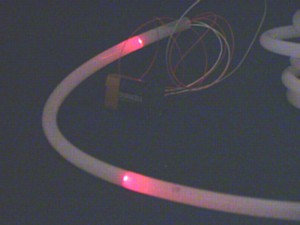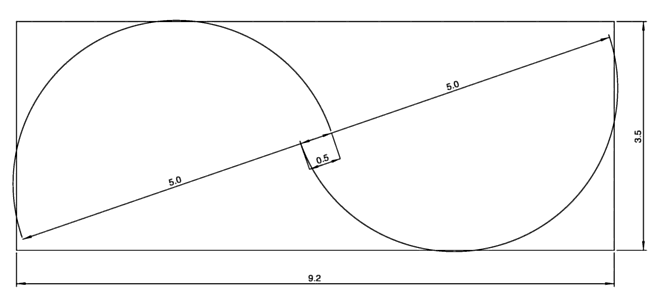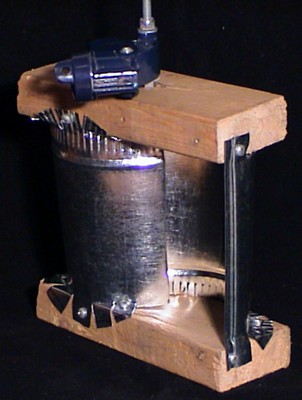Test polyethylene tubing
Posted: 2005-February-26 Filed under: Lighting, Projects, The Bike With 2 Brains Leave a comment »I tried out my idea of illuminating the polyethylene tubing and want to make sure a 12-inch spacing will look good enough. I quickly threw a test rig together and found the red clear LED's drop 2.2 volts, so the red LED needs a 340 ohm resistor for 20 mA with a 9-volt source. The red was adequate at a 12-inch spacing, throwing light about 3 inches down the tube — testing with brighter LED's should yield more perceived distance.
Savonius rotor test
Posted: 2005-February-18 Filed under: Power Source, Projects, The Bike With 2 Brains Leave a comment »I thought I bought 6" round duct pipe, but apparently it's actually 5" in diameter. Anyway, I played with it a bit and figured I could make a neat rotor using a 2×4. I put it in the CAD software to get the dimensions (note also that I'm using a 10% gap between blades at the axis which is recommended by most people.
The idea was to notch the ends of the pipe halves and bend them into tabs to screw onto 2×4's. I wanted to ensure that one tab extended to screw into the end of the 2×4 and that the arc of the pipe fell tangent to the edge of the 2×4 so I could put another screw in the side through a tab. What I found was to cut the 2×4 to 9.2 inches long.
I learned that it was important to ensure the bent tabs form parallel planes. My first rotor came out crooked … not by too much, but enough that it would vibrate like mad in even modest wind. (By the way, that's the axle from a baby stroller wheel that I used as a pivot point to test it.) That, and I should alternate my cut tabs inward and outward so they don't overlap on the inside of the curve. Oh, and that you can only screw into tabs that are on the outside of curve — I guess unless you've got a short screwdriver or make the pipe segments longer than I did.
The best part, though, is that the rotor is very rigid. I'll be more diligent about the next design, and I sure hope it will survive strong winds.
Computer hard drive windmill
Posted: 2005-February-2 Filed under: Power Source, Projects, The Bike With 2 Brains Leave a comment »I started with the spindle motor from an old hard drive. I figured it was a pretty nifty use: the permanent magnet 3-phase motor should make a cool generator, plus it will supply 3-phase power. Unfortunately, my hopes of hitting 20 watts with it are pretty much dashed.
I cut out a Compuserv CD into fan blades, heated it to bend them, and mounted it to the motor. With the air hose, I managed to get to 600 RPM (a far cry from the rated 5400 RPM) and dumped 30 volts into 1000 ohms for a power output of 0.9 watts. Indeed, the power rating on the drive indicated it was only supposed to draw about 6 watts total, so my chances of getting past 5 watts or so is not too likely. However, even 5 watts over 20 hours would provide me with enough power to run 10 watts of lighting and other stuff for 10 hours or so. At least the 100 watt-hours generated each day is far more than the 50 watt-hour capacity of the batteries I'm looking at. Oh, then I broke the blade.
Use 3-sided tomato cages to make signs to stick in the ground.
Posted: 2004-June-7 Filed under: General Leave a comment »If you're having a yard sale or just want to make a sign, an easy method is to use 3-sided tomato cages that fold flat. Unfold the cage and put your sign inside. Tape it in place across some of the wires to keep it from sliding up-and-down then fold the cage sides back onto the surface to keep it locked in place.
Stagger connections in electrical cord repairs to prevent short circuits.
Posted: 2004-June-2 Filed under: Electrical Leave a comment »To repair a broken electrical cord, unplug the appliance and cut the section of damaged cord out. Separate the wires on one side and cut each wire separately so the length of each wire is staggered about an inch-and-a-half away from the other ends. Separate the wires on the other end the same way and stagger them so they'll match up with the lengths on the first end (that is, the longest length on one end is the shortest on the other.) It's preferrable to solder the ends together side-by-side after stripping off a quarter-inch of insulation, but if you don't have a soldering iron, strip a half-inch of insulation off each of the wires and twist matching pairs from the two pieces of cord together. When the repaired cord is straightened, none of the bare wires should touch one another since they are at least an inch apart. Wrap the whole job in electrical tape or use heat-shrink tubing so you don't electrocute yourself.
Use ziplock bags to rainproof things in your pockets.
Posted: 2004-May-14 Filed under: Travel Leave a comment »Carry a couple ziplock-style bags when you go to an outdoor event that might get rained on. If it does rain, put the items that don't respond well to rain into the bags in your pocket. Even if you're soaked to the bone, your cell phone will survive.




Recent Comments